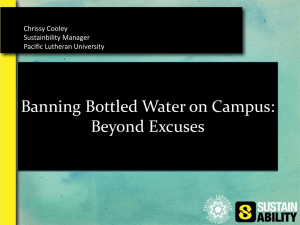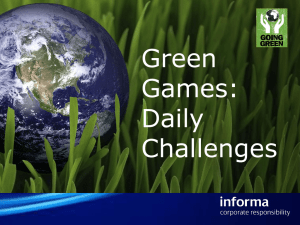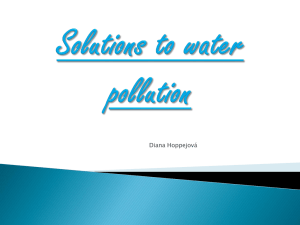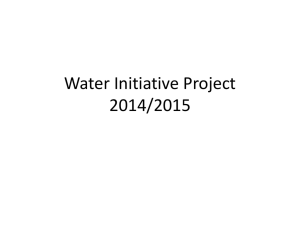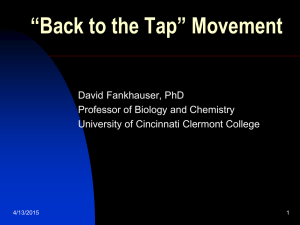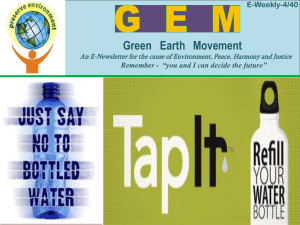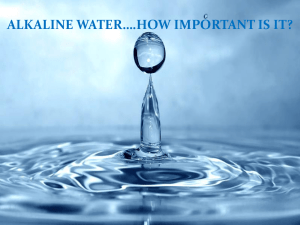Industry Analysis as a Word document
advertisement
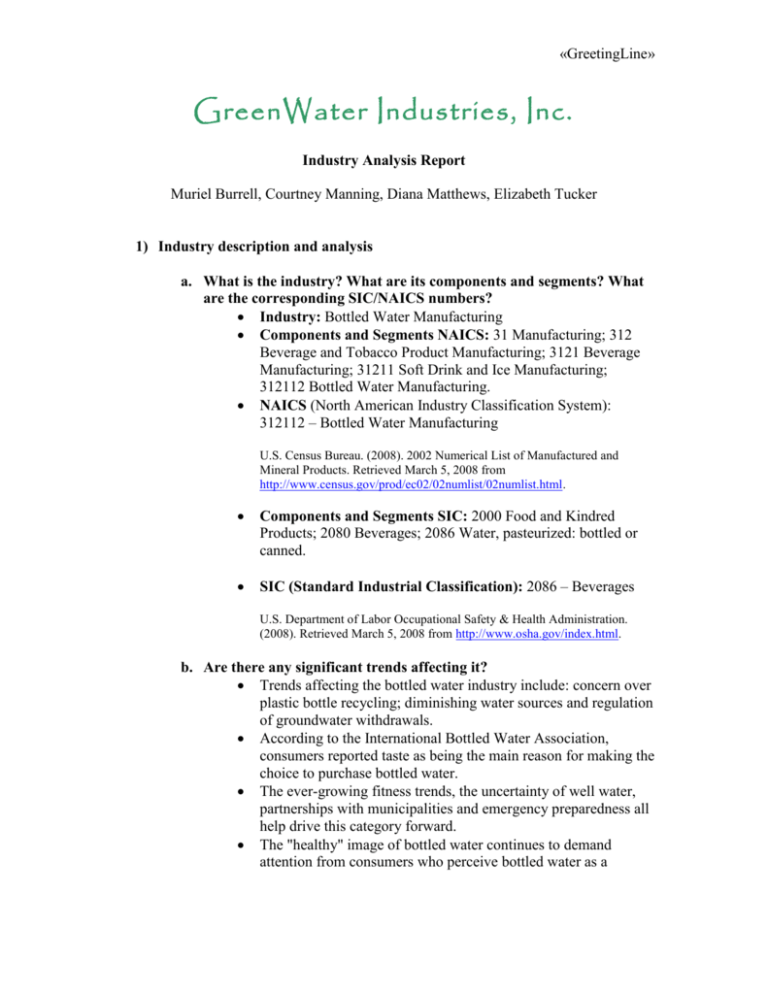
«GreetingLine» GreenWater Industries, Inc. Industry Analysis Report Muriel Burrell, Courtney Manning, Diana Matthews, Elizabeth Tucker 1) Industry description and analysis a. What is the industry? What are its components and segments? What are the corresponding SIC/NAICS numbers? Industry: Bottled Water Manufacturing Components and Segments NAICS: 31 Manufacturing; 312 Beverage and Tobacco Product Manufacturing; 3121 Beverage Manufacturing; 31211 Soft Drink and Ice Manufacturing; 312112 Bottled Water Manufacturing. NAICS (North American Industry Classification System): 312112 – Bottled Water Manufacturing U.S. Census Bureau. (2008). 2002 Numerical List of Manufactured and Mineral Products. Retrieved March 5, 2008 from http://www.census.gov/prod/ec02/02numlist/02numlist.html. Components and Segments SIC: 2000 Food and Kindred Products; 2080 Beverages; 2086 Water, pasteurized: bottled or canned. SIC (Standard Industrial Classification): 2086 – Beverages U.S. Department of Labor Occupational Safety & Health Administration. (2008). Retrieved March 5, 2008 from http://www.osha.gov/index.html. b. Are there any significant trends affecting it? Trends affecting the bottled water industry include: concern over plastic bottle recycling; diminishing water sources and regulation of groundwater withdrawals. According to the International Bottled Water Association, consumers reported taste as being the main reason for making the choice to purchase bottled water. The ever-growing fitness trends, the uncertainty of well water, partnerships with municipalities and emergency preparedness all help drive this category forward. The "healthy" image of bottled water continues to demand attention from consumers who perceive bottled water as a «GreetingLine» healthier alternative to sports drinks, juices, soft drinks and tap water. Water Quality Products: Bottled Water Industry Update. (September, 2006). Retrieved March 10, 2008 from http://www.wqpmag.com/%20Bottled-WaterIndustry-Update-article7245. c. Is the industry affected by any technological, economic, demographic, political or legislative developments? In what ways? Bottled water consumption is growing fastest worldwide in India and Asia. Many emerging economies are faced with providing safe drinking water to massively expanding urban populations that have confounded the existing urban systems, and as such, consumers are turning to packaged water, which includes bottles and poly bags. Safe drinking water is a major concern for governments. Bottled water remains the most efficient way to get safe, healthy drinking water to populations. Additionally, in many areas around the globe bottled water is the only source of safe water. With the shift in global populations from agrarian societies and regions to urban centers, the world will see the importance of packaged water remaining dominant. Water Quality Products: Bottled Water Industry Update. (September, 2006). Retrieved March 10, 2008 from http://www.wqpmag.com/%20Bottled-WaterIndustry-Update-article7245. d. Is this a “new” or an “old” industry? Bottled water manufacturing is not a new industry, however, it has changed significantly over the years. Water spas and the bottling of natural mineral waters had also become well established in North America at that time. In 1845, Poland Spring water was bottled for sale in three gallon demijohns. In South America, São Lourenço bottled water appeared in Brazil in 1890. American Beverage Association. History: Bottled Water. (2008). Retrieved March 10, 2008 from http://www.ameribev.org/all-about-beverage-productsmanufacturing-marketing--consumption/americas-beverage-products/bottleddrinking/history/index.aspx. e. What are the market analysts predicting and recommending about the industry? What is its outlook for the future? The bottled water industry is in the “consumer/non-cyclical” goods category. «GreetingLine» Google. Google Finance. Consumer – Non-Cyclical. (2008). Retrieved March 10, 2008 from http://finance.google.com/finance?client=ig&catid=52760568. Google. Google Finance. Consumer – Non-Cyclical. Beverages: Non-Alcoholic. (2008). Retrieved March 10, 2008 from http://finance.google.com/finance?client=ig&catid=52760568 http://finance.google.com/finance?catid=63796143. Market Forecast: Economic outlook for the bottled water industry is favorable and growth is expected to occur. In 2006, bottled water «GreetingLine» revenue in the United States was $15.6 billion, with a compound annual growth rate of 8.1% from 2002. It is the second largest commercial beverage category by volume in the United States in 2003. The European is even bigger, with $32.2 billion in revenue. Unflavored water comprises 89.6% of the market share. Globally, the United States comprises 25.6% of the market, while Europe is the biggest consumer, with 52.9% market share. Although profits can be high from bottled water, a fragmented market and the fact that retailers do not incur high switching costs can increase competitiveness, driving prices down. In 2011, the United States bottled water market is projected to grow 48.5% from 2006, and the global market is projected to grow 41.8%. “Supermarkets and hypermarkets form the most significant distribution channel in the US bottled water market, with a 71.6% share of the market's volume.” (DataMonitor). Bottled water contains no calories, fat, or cholesterol, making it a good choice for health-conscious consumers. As consumers are aging and waistlines grow, bottled water is set to become a viable alternative to other less healthy beverages, and profits will increase. U.S. consumption of bottled water grew 9.5% from 2005 to 2006, while soft drink consumption decreased 1.1%. Many public schools now ban soft drinks from their campuses, but bottled water, along with juice and low-calories offerings, remain. Water infused with vitamins and minerals, in particular, is forecast to grow heavily. Besides healthconsciousness, other attributes that heavily drive bottled water sales are concerns about local water supply and relative wealth of consumers. Datamonitor Industry Market Research. (2007, Nov. 15). Bottled Water Manufacturing (312112), United States. Retrieved March 28, 2008 from Business & Company Resource Center. Datamonitor Industry Market Research. (2007, Nov. 15). Bottled Water Manufacturing (312112), Global. Retrieved March 28, 2008 from Business & Company Resource Center. International Bottled Water Association. (n.d.). Retrieved March 28, 2008 from http://www.bottledwater.org/. Standard & Poor’s. (2007, December 13). Industry Surveys: Foods & Nonalcoholic Beverages. Retrieved March 28, 2008 from Standard & Poor’s NetAdvantage. 2) Major Players a. What are the most important companies in the industry? The most important companies in the water industry are Nestle Waters North America, PepsiCo, and Coca-Cola Corporation. b. Are there any “up-and-comers?” Numerous “boutique” water companies are born every year. However, these brands are usually attached to larger corporations like Coca-Cola, PepsiCo, or Nestle. «GreetingLine» c. What market share do the major players have in the industry? PepsiCo Inc., Purchase, New York, has the top U.S. bottledwater brand in Aquafina, which had a 14.5% market share, according to 2004 retail data compiled by Beverage Digest. Coke's Dasani brand, a purified tap water, was No. 2 with a 9.5% share. Organic Consumers Association. Coke Tightens Grip on North American Bottled Water Market. (April 22, 2005). Retrieved March 10, 2008 from http://www.organicconsumers.org/btc/cokewater050305.cfm. Nestlé Waters has a market share of 18% in terms of value and is recovering an indisputable leadership position in terms of volume. Nestle Waters. (March 7, 2006). Press. Retrieved March 10, 2008 from http://www.press.nestle-waters.com. The bottled water business is a $35 billion worldwide industry. It is considered the fastest-growing major U.S. beverage category. Water Quality Products: Bottled Water Zone. (September, 2007). Retrieved March 10, 2008 from http://www.wqpmag.com/Bottled-Water-Zone16. d. Is the industry represented by small growing companies, or by older giant companies? The industry is represented by older giant companies. e. Is there a global market for this industry and its U.S. companies, or are foreign companies posing a threat? There is a global market for the bottled water industry and its U.S. companies. Foreign threats have mostly been “absorbed” into the larger, more dominant U.S. companies. 3) Product Development a. What are the current issues in product development? Ground water filtration Plastic bottle technology Food value additives Flavored water Water bottled with individual and corporate names labeled Recycling b. Who are the primary researchers/research institutions? The primary researchers are those hired by the main corporations in the bottled water industry – mainly Nestle and Coke. Various research «GreetingLine» institutions are hired by the large corporations to conduct the research. Also, many universities across the country are engaged in water filtration, water conservation, and water packaging research (e.g. Auburn University in Auburn Alabama – see patent information below). c. Are patents being issued for the industry? In what areas? WATER BOTTLING and WATER BOTTLES Twist-open closure having inclined frangible membrane A closure for a container having an opening includes a base cap and an overcap that form a sealed chamber adjacent the opening that is isolated from the contents of the container. The base cap includes an outer skirt having container-engaging structure, a cylindrical well, a frangible membrane connected to the well along an inclined line of weakness and by a hinge member. The hinge member includes a pocket extending downward adjacent lower and upper terminuses of the line of weakness. The overcap includes a body having gripping structure, an inner skirt received within and rotatably connected to the well, and a cutting member depending from a lower end of the inner skirt received within the pocket such that the cutting member extends below the upper terminus. The cutting member severs the line of weakness upon substantial rotation of the overcap with respect to the base cap. A method of using the closure is also disclosed. Inventors: Ma; Mike Xiaoli (San Jose, CA) Assignee: Portola Packaging, Inc. (Batavia, IL) Appl. No.: 10/525,143 Filed: September 16, 2004 PCT Filed: September 16, 2004 PCT No.: PCT/US2004/030476 371(c)(1),(2),(4) Date: February 16, 2005 United States Patent and Trademark Office. USPTO EBC. Patent Portals. Patent Electronic Business Center. (2008). Retrieved March 11, 2008 from http://patft.uspto.gov/netacgi/nphParser?Sect1=PTO2&Sect2=HITOFF&p=1&u=%2Fnetahtml%2FPTO%2Fsearchbool.html&r=7&f=G&l=50&co1=AND&d=PTXT&s1=Bottled&s2=water&O. WATER BOTTLING and WATER BOTTLES CLAIM The ornamental design for a bottle, as shown and described herein. Inventors: Laupie; Marc (Nomexy, FR) Assignee: Nestle Waters North America (Greenwich, CT) Appl. No.: D/247,959 Filed: July 21, 2006 This is one of 12 bottle designs currently being patented by Nestle Waters North America «GreetingLine» United States Patent and Trademark Office. USPTO EBC. Patent Portals. Patent Electronic Business Center. (2008). Retrieved March 11, 2008 from http://patft.uspto.gov/netacgi/nphParser?Sect1=PTO2&Sect2=HITOFF&p=1&u=%2Fnetahtml%2FPTO%2Fsearchbool.html&r=1&f=G&l=50&co1=AND&d=PTXT&s1=%22Nestle+Waters%22&O S=%22Nestle+Waters%22&RS=%22Nestle+Waters%22. GROUND WATER FILTRATION United States Patent 7,341,664 Lee, et al. March 11, 2008 Method for forming an in situ groundwater filter A method and system for forming an in situ subsurface filter in a contaminated aquifer and for removing contaminants from groundwater drawn from a contaminated aquifer. The filter is produced in situ by injecting an aqueous solution comprising bacteriastimulating chemical components through a well to bioactively generate a subsurface mineral filtering zone surrounding the well. As water is subsequently drawn through the well, contaminants are removed from the water as it passes through the filtering zone. Inventors: Lee; Ming-Kuo (Auburn, AL), Saunders; James A. (Auburn, AL), Nichols, III; Samuel H. (Auburn, AL) Assignee: Auburn University (Auburn, AL) Appl. No.: 10/865,572 Filed: June 10, 2004 United States Patent and Trademark Office. USPTO EBC. Patent Portals. Patent Electronic Business Center. (2008). Retrieved March 11, 2008 from http://patft.uspto.gov/netacgi/nphParser?Sect1=PTO2&Sect2=HITOFF&p=1&u=%2Fnetahtml%2FPTO%2Fsearchbool.html&r=1&f=G&l=50&co1=AND&d=PTXT&s1=%22bottled+water%22&OS =%22bottled+water%22&RS=%22bottled+water%22. WATER WITH FOOD VALUE United States Patent 7,238,380 Stillman July 3, 2007 Water containing soluble fiber: A water-like fluid containing safe water and a significant quantity of soluble dietary fiber. The resulting solution is generally optically clear and has physical properties similar to potable water. The fluid is intended as a replacement for bottled, or other water, as a means to ensure proper hydration. Depending on the soluble fiber used the fluid is either non-caloric or extremely low in calories. The amount of soluble fiber is adjusted to a specific amount of water so that consumption of an adequate amount of fluid ensures hydration (e.g., eight 8 oz. glasses per day) will also providing an optimal amount of dietary fiber. This is particularly valuable in stressed situations where the diet may not provide adequate fiber without supplementation. The constant metered supply of fiber «GreetingLine» provided throughout the day is preferable to, and more convenient than, "bolus" administration of fiber through laxatives, etc. Additionally, the constant presence of soluble fiber in the digestive tract provides the known beneficial effects of moderating the postprandial increase in blood glucose, modulating serum lipid levels, and suppressing appetite. Inventors: Stillman; Suzanne Jaffe (Los Angeles, CA) Appl. No.: 10/204,572 Filed: February 22, 2001 PCT Filed: February 22, 2001 PCT No.: PCT/US01/05630 371(c)(1),(2),(4) Date: April 02, 2003 PCT Pub. No.: WO01/62108 PCT Pub. Date: August 30, 2001 United States Patent and Trademark Office. USPTO EBC. Patent Portals. Patent Electronic Business Center. (2008). Retrieved March 11, 2008 from http://patft.uspto.gov/netacgi/nphParser?Sect1=PTO2&Sect2=HITOFF&p=1&u=%2Fnetahtml%2FPTO%2Fsearchbool.html&r=1&f=G&l=50&co1=AND&d=PTXT&s1=%22bottled+water%22&OS =%22bottled+water%22&RS=%22bottled+water%22. WATER WITH MINERALS ADDED United States Patent 7,090,878 Mehansho, et al. August 15, 2006 Mineral fortified water A water composition that is fortified with at least one mineral and has a pH between about 2.5 and 9.5. The water composition has a redox potential that satisfies the following equation: 0.gtoreq.RP-(A-B*pH) wherein RP is the redox potential in millivolts of the mineralcontaining water composition, pH is the pH of the mineral-containing water composition, A is 400 and B is 20. The mineral is preferably selected from calcium, iron, zinc, copper, manganese, iodine, magnesium, and mixtures of these. Moreover, the mineral-fortified water composition is preferably substantially free of flavor or sweetener compounds. Even more preferably, the water composition has no metallic taste or after-taste, a Hunter colorimetric "b" reading of less than 5.0, and an NTU turbidity value of less than 5.0. The mineral-fortified water composition may optionally contain other nutrients and vitamins, for example, vitamin A, vitamin C, vitamin E, niacin, thiamin, vitamin B6, vitamin B2, vitamin B 12, folic acid, selenium, and pantathonic acid. Inventors: Mehansho; Haile (Fairfield, OH), Mellican; Renee Irvine (Bradenton, FL), Nunes; Raul Victorino (Loveland, OH), Marcano; Adrian Monsalve (Cincinnati, OH) Assignee: The Procter & Gamble Company (Cincinnati, OH) Appl. No.: 10/247,190 «GreetingLine» Filed: September 19, 2002 United States Patent and Trademark Office. USPTO EBC. Patent Portals. Patent Electronic Business Center. (2008). Retrieved March 11, 2008 from http://patft.uspto.gov/netacgi/nphParser?Sect1=PTO2&Sect2=HITOFF&p=1&u=%2Fnetahtml%2FPTO%2Fsearchbool.html&r=1&f=G&l=50&co1=AND&d=PTXT&s1=%22bottled+water%22&OS =%22bottled+water%22&RS=%22bottled+water%22. Are patents being awarded to other corporate entities or to academic and research institutions? The bottle patents are being awarded to corporations The filtration patent is being awarded to an academic institution The soluble fiber water patent is being awarded to an individual The mineral water patent is being awarded to a corporation d. What standards and regulations may be impacting the development and growth of the industry? International Bottled Water Association: the information resource for the bottled water industry. Model Code and Regulations Regarding Bottled Water. (2008). Retrieved March 11, 2008 from http://www.idswater.com/water/us/IBWA/bottled_water_code/15_0/g_supplier_6.html. «GreetingLine» International Bottled Water Association: the information resource for the bottled water industry. (2008). Model code and regulations regarding bottled water. Retrieved March 11, 2008 from http://www.idswater.com/water/us/IBWA/bottled_water_code/15_0/g_supplier_6.html. FROM THE NEWS: Green Water The bottled-water industry has taken a knock over claims that its product is bad for the environment. Now it's fighting back. Daniel McGinn Newsweek Web Exclusive Updated: 3:27 PM ET Aug 15, 2007 «GreetingLine» It's been a tough summer for the bottled-water industry. In June, the U.S. Conference of Mayors, led by San Francisco's Gavin Newsom, passed a resolution calling for a study of the negative environmental impact of bottled water and praising the high quality of municipal tap water. In July, under pressure from environmental activists, Pepsico announced it would begin adding "source labels" to bottles of Aquafina, making it clearer to consumers that the stuff inside is merely tap water that's been subjected to extra purification. And in the July issue of Fast Company magazine, award-winning writer Charles Fishman penned a highly critical story about Americans' $16 billion-a-year bottled-water habit, which he calls an "indulgence" in a world in which 1 billion people lack access to dependable water sources. "When a whole industry grows up around supplying us with something we don't need—when a whole industry is built on the packaging and the presentation—it's worth asking how that happened, and what the impact is," Fishman writes. Now the bottled-water industry is fighting back. On Friday, NEWSWEEK has learned, The New York Times and the San Francisco Chronicle will each carry a full-page ad containing a message from the International Bottled Water Association. This week's campaign will be the first industrywide advertising since 1999. In the ads, the industry pushes the notion that "calorie-free, refreshing water" is a healthy choice in a country where diabetes, obesity and heart disease afflict so many people. But beyond touting those healthy virtues, the ad also seeks to subtly reframe the debate. "Whether it comes from a faucet or a bottle, drinking water is an easy step people can take to lead a healthier lifestyle," the ad says. Much of this message is not new: the industry has spent years promoting the notion that Americans are better off drinking bottled water than soda or beer, and from a health standpoint, it's hard to argue with them. But lately more people—like the U.S. mayors— are comparing bottled water not to Coke or Budweiser, but instead to the free, clean stuff flowing out of taps. Since bottled water requires petroleum to create its containers, is often trucked across the country to supermarkets, and leaves millions of plastic shells behind in landfills after it's guzzled, that's a comparison that's necessarily less flattering. The messaging in the new ads—hey, it's all water, whether it's from a tap or a bottle— represents the latest twist in the industry's attempt to portray itself in better light. "It's unfortunate that we've gotten into this situation where [people are] pitting tap water against bottled water," IBWA president Joseph Doss told NEWSWEEK. "We don't disparage tap water and we just think it's a good thing if people are drinking water." Three in four Americans, according to industry research, drink both tap and bottled water, depending on where they are and what they feel like drinking. Consumers shouldn't look at bottled versus tap as an either-or proposition, the industry is suggesting. Instead, they should look favorably on both types of water, and consider bottled water when tap isn't an option. "[A]s far as we're concerned, the drink in everyone's purse, backpack and lunch box should be water," the ad proclaims. «GreetingLine» Activists aren't surprised by the industry's counterpunch. "Certainly, other industries that come under pressure roll out image advertising," says Patti Lynn, campaign director of Corporate Accountability International, which has been trying to educate consumers about the detriments of bottled water through an initiative it calls "Think Outside the Bottle." And even as the new ads hit consumers' doorsteps, environmental advocates are still working hard on the issue. They're urging the industry's two other big players, CocaCola and Nestlé, to follow Pepsico's lead and provide more information on their labels. They're also continuing calls for Aquafina to remove the mountain images from its label, which the group believes implies to consumer that the bottle contains mountain spring water. In the meantime, more cities are considering following the lead of San Francisco, which has banned city employees from using tax dollars to buy bottled water to consume at work. For a crisp, cool drink, it appears this will continue to be a long, hot summer. McGinn, D. (2007, August 2). Green Water: The bottled-water industry has taken a knock over claims that its product is bad for the environment. Now it's fighting back. Retrieved March 11, 2008 from http://www.newsweek.com/id/32589.
